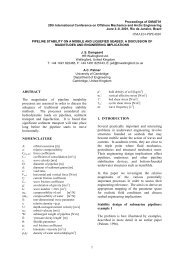Cantilever-like micromechanical sensors - Artek
Cantilever-like micromechanical sensors - Artek
Cantilever-like micromechanical sensors - Artek
You also want an ePaper? Increase the reach of your titles
YUMPU automatically turns print PDFs into web optimized ePapers that Google loves.
Rep. Prog. Phys. 74 (2011) 036101 A Boisen et al<br />
2.1.2. Sensitivity and resolution. From equation (2.9) itis<br />
clear that the resonant frequency depends on the vibrating<br />
mass. The change in resonant frequency due to a change in<br />
mass is called the sensitivity S of a resonant mass sensor. This<br />
is a very important parameter for bending beam-based mass<br />
<strong>sensors</strong>, since it in turn will determine the minimum detectable<br />
mass.<br />
Assuming that the change in mass, m, is very small<br />
compared with m0 and distributed evenly over the entire<br />
resonant beam surface, the mass sensitivity of a beam can be<br />
found by differentiation of equation (2.9) with respect to the<br />
mass of the beam:<br />
S = ∂ω0<br />
∂meff<br />
=− ω0<br />
2meff<br />
≈ ω0<br />
, (2.11)<br />
m<br />
where ω0 is the change in the resonant frequency caused by<br />
an added mass, m.<br />
To obtain a high sensitivity a beam must have a high<br />
resonant frequency, which can be obtained by having a<br />
large Young’s modulus, low density and small dimensions.<br />
Furthermore, it must have a low mass, requiring a low density<br />
and small dimensions. Thus, for bending beams a higher<br />
sensitivity can be obtained at higher vibrational modes due to a<br />
decreasing effective mass at higher modes [39]. Also, doubly<br />
clamped beams have higher resonant frequencies than singly<br />
clamped beams of same dimensions. However, the vibrational<br />
amplitude is smaller and the doubly clamped structures are<br />
therefore in general more difficult to read-out.<br />
The resolution, that is the smallest detectable mass of the<br />
sensor, mmin, is given by the inverse sensitivity times the<br />
minimum detectable frequency change ωmin:<br />
mmin = S −1 ωmin. (2.12)<br />
The frequency stability and thereby ωmin is determined by the<br />
noise of the system originating from both the read-out circuitry<br />
and the resonator itself [29].<br />
2.1.3. Damping and noise. A beam with a kinetic energy<br />
will experience damping and thereby dissipation of its kinetic<br />
energy. The dissipation is defined as the ratio of energy<br />
lost per cycle to the stored energy, and is the inverse of the<br />
quality factor (Q-factor). The damping will cause a broadening<br />
of the resonant peak and introduce frequency noise, thereby<br />
increasing the minimum detectable change in frequency.<br />
Dissipation occurs through several mechanisms that<br />
are either intrinsic to the cantilever or due to extrinsic<br />
processes. The intrinsic processes are, among others,<br />
material damping (phonon–phonon interactions, phonon–<br />
electron interactions, thermo-elastic damping) [40–42] and<br />
anchor losses [40, 43, 44]. Extrinsic dissipation occurs due to<br />
interactions with the surrounding media and can be controlled<br />
by mode of operation and atmospheric pressure. The total<br />
dissipation is the sum of all contributions<br />
1<br />
Q = 1<br />
+<br />
Qint<br />
1<br />
Qext<br />
+ 1<br />
+<br />
Qanc<br />
1<br />
+ ···.<br />
Qsur<br />
= 1<br />
+<br />
Qair<br />
1<br />
Qmat<br />
5<br />
Figure 4. Schematic of a cantilever with a single bead, having the<br />
mass m, positioned at zm.<br />
For bending beam resonators operated under ambient<br />
conditions viscous damping or momentum exchange with the<br />
surrounding medium is the dominant source of dissipation,<br />
giving rise to low Q-factors (around 100) [29]. Thus, highsensitivity<br />
beam-based mass <strong>sensors</strong> are generally operated at<br />
low pressures [45]. If a beam is a sandwiched structure, such<br />
as a metal-coated silicon cantilever, material damping can be<br />
dominant [46, 47].<br />
Pre-stressed doubly clamped beams have been seen to<br />
have extraordinary high quality factors [48] and in polymeric<br />
doubly clamped beams the material damping is significantly<br />
reduced when the beams become string <strong>like</strong> [49]. Clamping<br />
loss is one of the limiting damping effects for resonant strings<br />
[49, 50]. By improving the clamping, quality factors of up<br />
to 4 million have been obtained with silicon nitride microstrings<br />
[51].<br />
Often, beam-based mass <strong>sensors</strong> are affected by noise<br />
attributed to individual molecules that adsorb and desorb on<br />
the surface of the beam [29]. This process changes the mass<br />
and thereby the resonant frequency of the beam. Also, the<br />
read-out system introduces noise which is associated with<br />
the transduction of the mechanical response into an electrical<br />
signal and which is highly dependent on the method of choice<br />
[27, 52–57].<br />
2.1.4. Position dependent mass measurements. In the<br />
previous section the mass of adsorbed molecules is assumed<br />
to be distributed uniformly over the beam surface. This<br />
approach is not viable if single molecules or particles are to<br />
be measured, since the change in resonant frequency is not<br />
only dependent on the mass of the attached particle but also<br />
on the position on the beam [39, 58, 59]. This is due to the<br />
shape of the vibrational modes. The areas of the beam with<br />
a large vibrational amplitude are areas where an added mass<br />
will gain a high kinetic energy and thereby change the resonant<br />
frequency considerably compared with the nodal points where<br />
no energy is transferred from the beam to the added particles.<br />
Consider a cantilever with the mass m0 loaded with a point<br />
mass m positioned at zm (figure 4). If the mass load is much<br />
less than the cantilever mass, m ≪ m0, the cantilever modeshape<br />
will not change significantly, and the resonant frequency<br />
of such a system can be accurately estimated using an energy<br />
approach. According to Rayleigh’s method the time average<br />
kinetic energy, Ekin, equals the time average strain energy,<br />
Estrain, at resonance [60].





